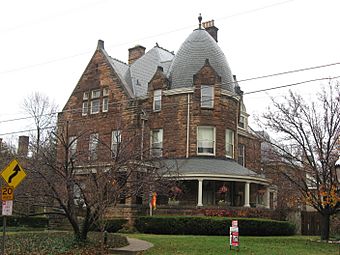Charles B. Russell House facts for kids
Quick facts for kids |
|
|
Charles B. Russell House
|
|

Front of the house
|
|
| Location | 3416 Brookline Ave., Cincinnati, Ohio |
|---|---|
| Area | Less than 1 acre (0.40 ha) |
| Built | 1890 |
| Architect | Samuel Hannaford & Sons |
| Architectural style | Late Victorian, Victorian Eclectic |
| MPS | Samuel Hannaford and Sons TR in Hamilton County |
| NRHP reference No. | 80003081 |
| Added to NRHP | March 3, 1980 |
The Charles B. Russell House is a special old home in the Clifton neighborhood of Cincinnati, Ohio, United States. It's also sometimes called the "Duffel Building." Built in 1890, this big house has two and a half stories. It is made mostly of strong limestone.
The house has many windows, including some cool dormer windows that stick out from the roof. One large dormer window on the south side looks a bit like a Palladian design. This is a classic style. A neat design feature is how stone lines, called string courses, connect the windows. Stone pieces, called voussoirs, also spread out from the windows.
Two of the most unique parts of the house are its heavy stone front porch and a large round tower. The porch changes from an open verandah to a closed sun porch. The round tower, called a turret, is on the front corner. It has a cool beehive-shaped top.
Who Was Charles B. Russell?
Charles B. Russell was an important businessman in Cincinnati. He was the treasurer for the Cincinnati Ice Company. This company provided ice to homes and businesses. Many local breweries used their ice.
Russell's house sits on a strong stone foundation. Its walls are built from rough, uneven stone blocks called ashlar. The roof is made of slate.
The Architect: Samuel Hannaford
The Charles B. Russell House was designed by a famous architect named Samuel Hannaford & Sons. This style of building was common for Hannaford's designs in the early 1890s. All five stone houses he designed between 1890 and 1892 have these rough stone walls.
During the late 1800s, Hannaford designed many beautiful homes like the Russell House. Rich businessmen and politicians of the Gilded Age loved his designs. Wealthy neighborhoods in Cincinnati, like Clifton, Walnut Hills, and Avondale, had many grand Hannaford houses.
What Happened to the House?
After Charles B. Russell moved out, the house had several different owners. An attorney named Thomas S. Pogue bought it in 1905. Today, it is no longer a single-family home. It has been changed into apartments.
Many of Hannaford's important buildings in the Cincinnati area were torn down in the 1900s. However, dozens of his buildings are still standing today.
In 1978, fifty-five different Hannaford buildings in or near Cincinnati were recognized as important. This included the Russell House and nineteen other homes. They were all added to the National Register of Historic Places in 1980. The Russell House was included because of its important and unique architecture. Its design was considered significant for the entire state.



